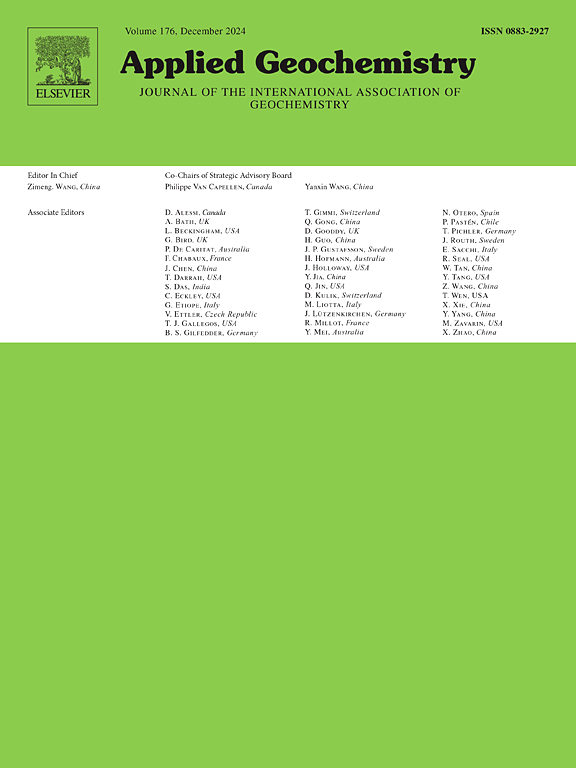Biomineralization for rock debris stabilization: Insights from the natural cementation phenomenon
IF 3.4
3区 地球科学
Q1 GEOCHEMISTRY & GEOPHYSICS
引用次数: 0
Abstract
Natural cementation of rock debris is a spontaneous geochemical process that plays an important role in geotechnical stabilization. The focus of this study is to analyze the natural cementation phenomenon in mudslide-prone areas using mineralogical and biological methods. We analyzed the formation of the natural cementation phenomenon by studying its mineral composition, elemental endowment distribution, mechanical properties, and community structure. Similarly, simulated cementation experiments of rock debris by carbonate mineralizing bacteria were carried out in the laboratory to assess the feasibility of biomineralization in the stabilization of rock and soil. The results show that the natural cementation of rock debris in mudslide-prone areas is caused by the formation of calcite under chemical action, and microorganisms also contribute to it; this cementation has multiple environmental protection significance, including improving the compressive properties of rock debris (up to 2.58 Mpa), slowing down or preventing the occurrence of geologic hazards such as slumps, landslides, etc., and significantly decreasing the migratory properties of heavy metal ions and its ecological risks. Laboratory simulation conditions showed that carbonate mineralizing bacteria were enabled to utilize the Ca2+ provided by weathering to achieve rapid cementation of the rock debris, which played an important role in the increase of their compressive strength and the improvement of their pore parameters. This study provides a theoretical basis for future engineering applications of biomineralization technology.

岩石碎屑稳定的生物矿化:来自自然胶结现象的见解
岩屑的自然胶结是一个自发的地球化学过程,在岩土稳定中起着重要作用。本研究的重点是利用矿物学和生物学的方法对泥石流易发地区的自然胶结现象进行分析。通过对天然胶结现象的矿物组成、元素禀赋分布、力学性能和群落结构的研究,分析了天然胶结现象的形成。同样,在实验室中进行了碳酸盐矿化细菌对岩屑的模拟胶结实验,以评估生物矿化在稳定岩石和土壤中的可行性。结果表明:泥石流易发区岩屑的自然胶结是由方解石在化学作用下形成的,微生物对其也有促进作用;这种胶结具有多重环境保护意义,包括改善岩屑的抗压特性(可达2.58 Mpa),减缓或防止滑坡、滑坡等地质灾害的发生,显著降低重金属离子的迁移特性及其生态风险。实验室模拟条件表明,碳酸盐矿化细菌能够利用风化提供的Ca2+实现岩屑的快速胶结,这对岩屑抗压强度的提高和孔隙参数的改善起到了重要作用。本研究为未来生物矿化技术的工程应用提供了理论基础。
本文章由计算机程序翻译,如有差异,请以英文原文为准。
求助全文
约1分钟内获得全文
求助全文
来源期刊

Applied Geochemistry
地学-地球化学与地球物理
CiteScore
6.10
自引率
8.80%
发文量
272
审稿时长
65 days
期刊介绍:
Applied Geochemistry is an international journal devoted to publication of original research papers, rapid research communications and selected review papers in geochemistry and urban geochemistry which have some practical application to an aspect of human endeavour, such as the preservation of the environment, health, waste disposal and the search for resources. Papers on applications of inorganic, organic and isotope geochemistry and geochemical processes are therefore welcome provided they meet the main criterion. Spatial and temporal monitoring case studies are only of interest to our international readership if they present new ideas of broad application.
Topics covered include: (1) Environmental geochemistry (including natural and anthropogenic aspects, and protection and remediation strategies); (2) Hydrogeochemistry (surface and groundwater); (3) Medical (urban) geochemistry; (4) The search for energy resources (in particular unconventional oil and gas or emerging metal resources); (5) Energy exploitation (in particular geothermal energy and CCS); (6) Upgrading of energy and mineral resources where there is a direct geochemical application; and (7) Waste disposal, including nuclear waste disposal.
 求助内容:
求助内容: 应助结果提醒方式:
应助结果提醒方式:


